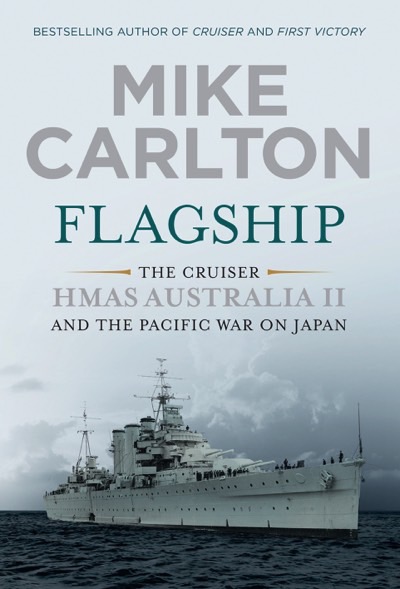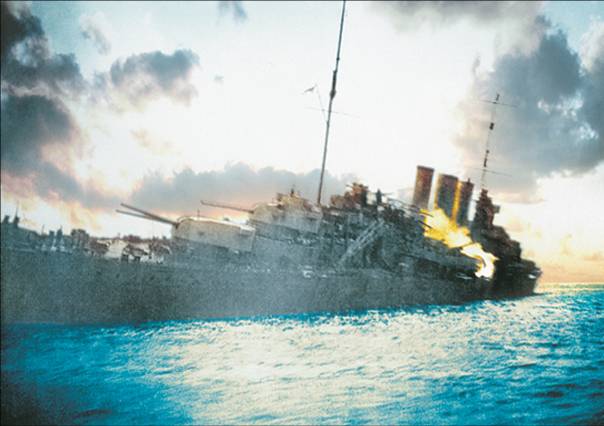
Flagship: The Cruiser HMAS Australia II and the Pacific War on Japan. By Mike Carlton. Penguin Random House, North Sydney, 2016.
Review by Desmond Woods.
SOME naval history books traverse well worn tracks where many authors have been before and contribute little that is new or engaging. Mike Carlton’s new book ‘Flagship’ is not such a book. On the contrary, this book has been missing from the literature. It is a timely book that will fill the general void in the public’s understanding of the Royal Australian Navy’s war at sea 1939 – 45 and the Pacific campaign in particular.
It is remarkable how many of our fellow citizens are well versed in the stories of Tobruk, Alamein, the Fall of Singapore and the battles for the Kokoda Track. Whereas the loss of the light cruiser HMAS SYDNEY with all 645 of her men off WA in 1941 has been exhaustively retold, the lives of the sailors who served in the ships of the RAN, and the Australian merchant navy in the Pacific war remains largely unknown.
The RAN deployed to war in the Pacific in December 1941 to stem the Japanese invasion of South East Asia and Australia’s northern waters. By January 1943 the USN and the RAN with the RAAF had secured the sea lanes from an enemy that had planned to dominate Australia’s links to the world as a part of its plan to maintain Japanese dominance in the South West Pacific.
We are approaching the 75th anniversary of the Battle of the Coral Sea, where the Japanese advance was first halted. The story told in ‘Flagship’ of how Admiral Jack Crace, originally from Gungahlin near Canberra, took his RAN /USN squadron and blocked the Jomard passage to the Japanese should be better known and its significance more widely understood. Crace and his men, RAN and USN, despite being under air attack fought and survived and in doing so deterred the Japanese High Command from attempting to carry out their plan for a seaborne invasion of virtually defenceless Port Moresby.
Flagship covers the tragic night battle at Savo Island off Guadalcanal, the bombardment of New Guinea beaches as the allies went north and the vast sea battles off the Philippines at Leyte Gulf, Surigao Strait and Lingayen Gulf, when the Japanese surface fleet ceased to exist as a fighting fleet. These events are infrequently recalled and not formally taught to a rising generation.
The few Australians with whom the names of these sea battles may resonate have little or no understanding that cruisers and destroyers of the RAN fought with the USN, and later the powerful British Pacific Fleet, right through the Pacific campaign from 1942 – 1945.

During those years RAN and USN ships sustained the allied armies fighting in jungles. They poured naval gunfire down on Japanese coastal strongpoints and softened up resistance saving thousands of allied soldiers and marines from virtually certain death as they disembarked from landing craft. Flagship brings these engagements vividly back to attention.
The RAN paid a very high price in fine ships and young lives for being in the thick of the fight so often and for so long.
The repeated and often fatal kamikaze attacks which HMAS AUSTRALIA’s crew endured in late 1944 and early 1945, while continuing to do their duty, should be the stuff of national inspiration. It is not.
Why is there such a blind spot in the general knowledge of the RAN’s role in the Pacific? What accounts for this national amnesia? It may owe much to the lack, until now, of one good book which is available and easily read by any who wish to learn what happened to Australian sailors at war in the Pacific. Australia’s naval history in World War II is a significant part of the nation’s story and deserves to be formally taught to each generation. ‘Flagship’ is the book every school could use for this purpose.
Sterling work has been done by generations of naval historians who have explained in ships histories where the RAN was in action. The sacrifices of the men who fought their ships is well documented. But much of that work is long out of print and none of those writers, since the official historian of the RAN in WWII, G.H. Gill, have worked on such a wide canvas as ‘Flagship’ does. This book tells the whole story of the contribution of the heavy cruisers, AUSTRALIA and SHROPSHIRE made in the countless engagements large and small which led inexorably to the Japanese surrender in Tokyo Bay.
But this is not a dry account of maritime campaigns only of interest to naval history buffs. ‘Flagship’ is a rattling good read, full of fascinating detail and grounded in excellent research aided by the professional historians at the Sea Power Centre –Australia where the Navy keeps its historical archives.
‘Flagship’ is also a social history of a very particular, never to be repeated, human experience. It asks, and answers, the question how did young Australian civilians transform and adapt to what the Naval Prayer calls “the dangers of the sea and the violence of the enemy.”
‘Flagship’ reaches into the cruisers mess decks and gunrooms and tells through their letters and diaries the stories of the young men who lived there, often for years, while their ship carried them into danger and back out again. Here are the lives of those who lived and returned to Australia, and those who were killed in action and buried at sea by their grieving shipmates, usually the same day.
‘Flagship’ also deals with the role that the American High Command in Australia and the Australian Naval Board played in the decisions about where and when the RAN went into action. Key allied commanders and their political masters made choices which determined the outcome of the Australian contribution to the war in the Pacific.
The manifest failures that led to disaster at the night battle of Savo Island and the loss of HMAS CANBERRA are not glossed over and the sad truth that it was a badly aimed, hastily fired, American torpedo which first crippled the Australian cruiser is not shied away from. This fact has been widely accepted and documented since 1994 when it was fully explained by those RAN officers who were there and much later in life gained access to the USN’s archives. It is right that this sad truth should be re-stated with supporting evidence.
But also here is the epic account HMAS CANBERRA’s surviving crew who recovered from the loss of their captain, their ship and shipmates and went to war again in HMAS SHROPSHIRE, an RN cruiser freely given by Winston Churchill to the RAN. Her guns crews avenged their eighty four dead CANBERRA shipmates when they attacked the Japanese battle line at Surigao Strait and earned the high praise of the Americans for the speed and accuracy of their 8 inch salvos.
That is a great Australian example of “never say die” and ‘Flagship’ tells that story, and many others, with the generosity, accuracy and the compassion which the men who lived these quietly heroic lives richly deserve.
The generation of RAN sailors who went to war in the Pacific in AUSTRALIA, CANBERRA and SHROPSHIRE are very nearly all gone now. The author interviewed the few who are left and recorded their memories. These last sailors standing were very young when they went to war but their insights and memories bring freshness to the battle scenes described. The author also read the unpublished accounts, held in private family archives, of those who wrote what they remembered of the times they survived. More work on the RAN in the Pacific war awaits those historians who wish to explore further into the archives and diaries.
This well illustrated, very substantial new book of 560 pages does justice to those men who are still with us, to those who were killed by kamikaze attacks at their action station in HMAS AUSTRALIA, to those men who came home from war and lived their lives among us. It pays tribute to those eighty four sailors and officers who still lie in Iron Bottom Sound, off Savo Island, with their lost cruiser, HMAS CANBERRA.



